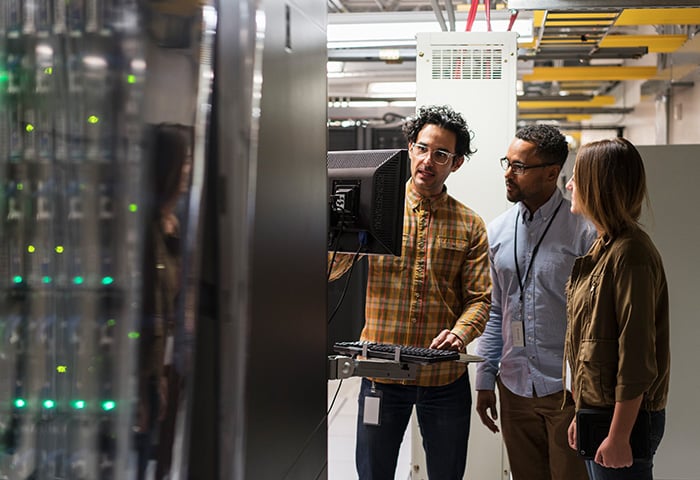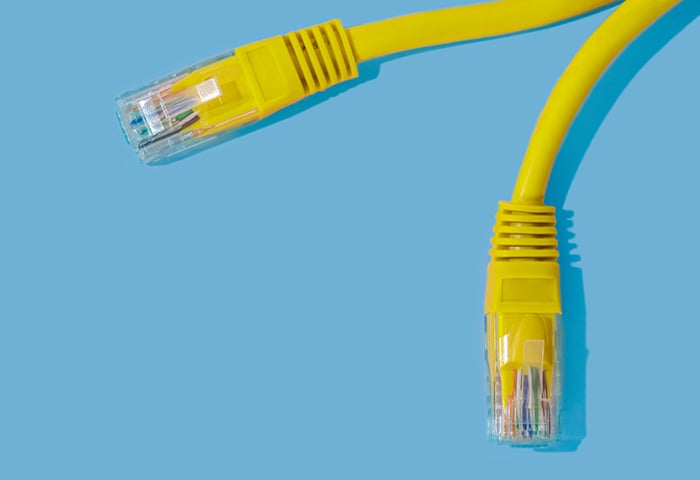What is IPv4?
IPv4 (Internet Protocol version 4) is the standard address format that lets all machines on the internet communicate with one another. IPv4 is written as a 32-bit string of digits, and an IPv4 address is composed of four numbers, each between 0 and 255, and separated by periods.
You might know what an IP address is, and you’ve probably seen your own, which looks something like this: 168.213.226.204. IPv4 allows for over 4 billion different addresses, and it has served us well for decades.
Key features of IPv4
Introduced in 1978, IPv4 standardized the way computers on the internet talk to one another. It is a connectionless protocol, meaning that data can be sent out without requiring parties to spend time establishing a direct connection, and it requires only small amounts of memory.
IPv4 provides for over 4 billion unique addresses, which seemed like more than enough back then — but a lot can change over 40 years. As more and more devices come online, IPv4 is hitting its limits.
We need a new standard. Thankfully, we have a suitable candidate, one that’s already being used by millions of computers. It’s called IPv6.
What is IPv6?
IPv6 (Internet Protocol version 6) is an updated standard for identifying computers on the internet. Like IPv4, it gives every device a unique identifier, but one that has been adjusted to accommodate the increasing number of computers connected to the internet today.
IPv6 increases the number of possible IP addresses from IPv4’s 4 billion all the way up to 340 trillion trillion trillion. IPv6 is written as a 128-bit hexadecimal string of digits, and a typical IPv6 address looks something like this:
2001:0ab8:85a2:0000:0000:8a3e:0370:7334
IPv6 has been streamlined to keep up with today’s modernized internet. That means getting rid of certain components of the IPv4 system that are no longer necessary, which we’ll get into below.
Key features of IPv6
IPv6 streamlines data transfers by making any two addresses directly accessible to each other again. IPv4 had to introduce additional steps to compensate for the relative lack of unique address.
No longer will each packet of received data need to be checked to make sure it’s identical to what was sent, for example, as is necessary under a connectionless protocol. IPv4 uses a process called checksum to verify the integrity of the data being sent. Checksum is often performed multiple times, since a router directs traffic to multiple computers on one address. When each device can have its own permanent address, configuring them will become much simpler.
Think of it like the difference between a letter getting sent to your old address and then forwarded to you vs. a letter being sent directly to your house.
IPv6 has been built to make data move more efficiently. Support for Quality of Service (QoS) means a more efficient allocation of resources. When your internet speed is slow or limited, QoS prioritizes which bits of data should go first. It's not really a question of “should I use IPv6?” — it’s more about the benefits we’ll all enjoy with it.
What's the difference between IPv4 and IPv6 addresses?
The difference between IPv4 and IPv6 addresses is that IPv6 addresses are longer and formatted differently, so there are more possible unique IPv6 address configurations. IPv4 is a 32-bit system using a string of numbers separated by periods, whereas IPv6 is a 128-bit system using alphanumeric sequences separated by colons.
Here’s a closer look at the differences between IPv4 vs. IPv6:
/IPv4-vs-IPv6-EN.png?width=1320&name=IPv4-vs-IPv6-EN.png)
So is IPv6 better than IPv4? In a practical sense, definitely. Communicating over the internet is much more efficient when every device has its own unique address, and this is possible only with IPv6.
/icon_02.svg) Speed: IPv4 vs. IPv6
Speed: IPv4 vs. IPv6
While the larger IPv6 header means that more data accompanies each transfer, the streamlined structure actually enables a quicker send. Under IPv4, most of the data you receive goes through an IP address shared by many others before getting forwarded to you. IPv6 communication takes less time, because one device sends data directly to another.
Direct connections ensure that all messages are received intact. Recall that IPv4 checks for errors at multiple points during the communication, prolonging the transfer time. By contrast, IPv6 checks for accurate data transmission at the TCP level. For the most part, we’ll see an uptick in internet speeds thanks to IPv6.
/icon_01.svg) Security: IPv4 vs. IPv6
Security: IPv4 vs. IPv6
Being just one port in a sea of 340 trillion trillion trillion IP addresses will not be enough to hide your IP address. Hackers are sleuths who have trained themselves to predict human behavior. Patterns in data organization will be just as detectable with IPv6 addresses.
Nobody becomes more secure automatically by using IPv6 — in fact, it may be far less secure in the short term. IPv6 is relatively new and unfamiliar, and so is the process of configuring it. While most people are figuring it out, hackers and cybercriminals may take advantage of vulnerabilities that can be exploited on the level of network protocol.
With IPv6, it’ll be just as important as ever to strengthen your computer's security. Have hackers ever stopped finding new ways to steal data or make money? With AVG SecureVPN, you can be sure you're shielding your IP address and your internet activity from anyone trying to find out who you are or what you’re doing.
How can I tell which type of IP address I'm using?
There are many ways to find out your IP address, including simply googling “what is my IP?” It doesn't get much easier than that. You can find out your IP address easily from within Windows, macOS, or Linux, as well.
While you’re at it, figure out whether your IP address is public or private, and static or dynamic. These factors are relevant in certain situations, and it may help to know a little bit more about them.
Why was IPv6 created?
IPv6 was created because the internet is running out of IPv4 addresses. IPv4 allows for just over 4 billion unique addresses. But as of October 2020, 4.66 billion people had access to the internet, many with more than one personal device. So the internet needs to accommodate more IPs.
As far back as the 1990s, the Internet Engineering Task Force (IETF) knew that IPv4 would run out of possible addresses, and that the number of devices connected to the internet would eventually dwarf the number of possible IPv4 addresses. So the IETF started devising a new 128-bit system, ensuring that there would be enough addresses for the foreseeable future.
By the way, “32-bit” refers to a method of writing out a bunch of numbers, and it has a defined number of possibilities — the four numbers between 0 and 255 that we discussed earlier. A 128-bit system has more bits, so it can accommodate a larger set of numbers.
Thousands of internet service providers (ISPs) agreed to make IPv6 the new standard in 2012, with the transition process still ongoing today. And not a moment too soon, as our ability to use IPv4 is about to hit its limit.
Have we run out of IPv4 addresses?
Practically, no — but technically, yes. There are no more new IPv4 addresses, and we've only managed to continue using the old ones through some clever but temporary fixes.
Your ISP probably makes use of NAT (network address translation), which assigns you to a shared IP address and gives your device an internal IP address within that group. Due to IPv4 address shortages, an additional system was created to keep the internet alive, complete with error-correction mechanisms.
/IPv4-run-out.svg) The IP addresses in this image are used for explanatory purposes only. As “broadcast addresses,” they can’t be assigned to an individual computer.
The IP addresses in this image are used for explanatory purposes only. As “broadcast addresses,” they can’t be assigned to an individual computer.
Switching to IPv6 will simplify the whole process. Your IP address will be your IP address, period. If you've ever had to deal with port forwarding, it was because your computer was isolated from the internet by NAT. The data had to be “forwarded” to your specific computer, since yours was one of many machines being serviced by the same IP address. With IPv6, there will be no more jumping through hoops just to make a connection.
The number of possible IPv4 addresses vs. IPv6 addresses means that communicating online will be much more straightforward under the IPv6 standard. As the number of devices online continues to increase, we’re closer to exhausting even our capacity for NAT.
Why haven't we switched to IPv6 completely?
Switching to IPv6 disrupts business as usual. ISPs and companies need to maintain productivity, and people don’t want interruptions to their internet service. As long as the transition is only forward-looking but not strictly necessary, it’ll be an uphill climb.
Being an early adopter will make it harder for everyone else to connect with you, and the expense of implementing new hardware may be hard to justify while everyone else continues to do business the old way.
Also, because IPv4 is not compatible with IPv6, a mechanism was created on top of IPv6 to allow communication between the two standards. Eventually, though, the move from IPv4 to IPv6 will be permanent.
Is it possible to switch off IPv6?
You can disable IPv6 on Windows, macOS, and Linux systems, but some components will stop working. The more we transition, the more your computer will require an IPv6 address.
Some people disable IPv6 for security reasons. Although IPv6 is not inherently less secure than IPv4, some security complications have arisen and will continue to crop up during the transition.
IPv4 may be safer until the transition is further along, but it also might introduce some instability. Your computer may crash due to driver incompatibility, and it’s often best to simply stick with what the manufacturer has configured. Disabling IPv6 may be more trouble than it's worth, so always use the best antivirus security software you can find — and make sure to keep all your software updated.
Stay anonymous with IPv4 or IPv6
Whether you're using IPv4 or IPv6, a VPN (or virtual private network) will keep you both private and secure. AVG Secure VPN is designed to hide your IP address and protect your anonymity online.
AVG Secure VPN not only encrypts your personal data; it also allows you to disguise yourself behind a new IP address. Websites, advertisers, hackers, and government agencies won’t be able to tell who you are or what you’re doing online, which will make tracking your activity extremely difficult. Try AVG Secure VPN today.
/IPv4-vs-IPv6--Hero.jpg?width=1200&name=IPv4-vs-IPv6--Hero.jpg)
/IPv4-vs-IPv6-EN.png?width=1320&name=IPv4-vs-IPv6-EN.png)












